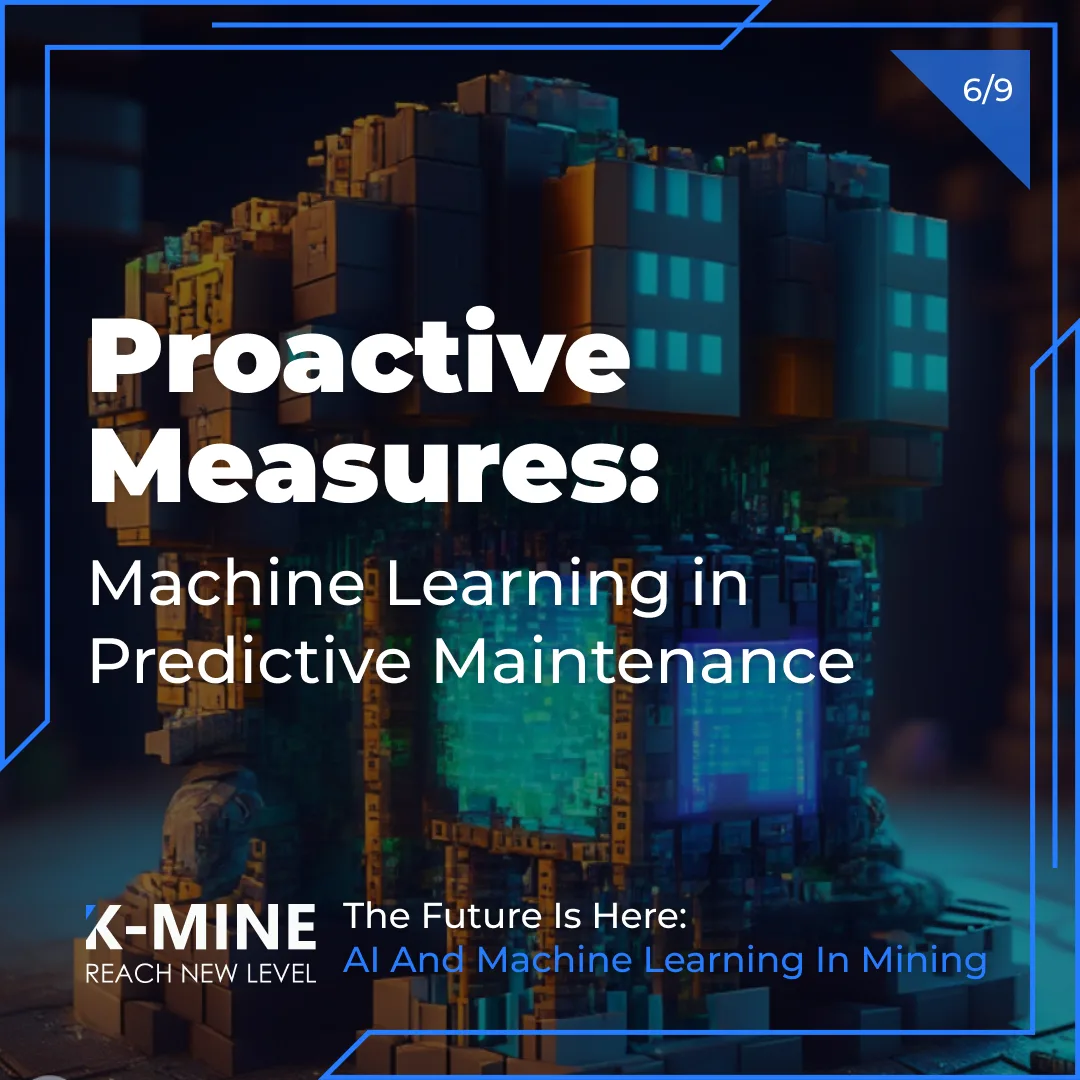
The Future is Here: AI and Machine Learning in Mining. Part 6
Content
In the high-stakes world of mining, the upkeep of machinery can make or break an operation. The unpredicted failure of a single piece of equipment can lead to costly downtime, safety hazards, and a significant reduction in productivity. Traditional preventive maintenance methods, while essential, often fall short in accurately predicting equipment failures. This is where the transformative potential of machine learning comes into play.
Machine learning, a subset of artificial intelligence, holds the promise of revolutionizing predictive maintenance in mining. By leveraging vast amounts of data, machine learning can provide remarkably accurate predictions about when a piece of machinery might fail, enabling mining companies to take proactive measures to maintain their equipment. This is not a far-off future scenario; it is happening now.
Over the course of this article, we will explore how machine learning is being harnessed to optimize predictive maintenance, thereby minimizing downtime, enhancing safety, and ultimately improving the bottom line in mining operations. Welcome to the era of predictive maintenance, enhanced by machine learning!
Understanding Predictive Maintenance
Predictive maintenance, in essence, is the practice of utilizing condition monitoring data to anticipate when equipment might fail. By doing so, maintenance work can be scheduled proactively, potentially preventing catastrophic failure, increasing equipment longevity, and ensuring safer and more efficient operations.
In the realm of mining, predictive maintenance is of paramount importance due to the sheer scale and intricacy of the equipment used. The unexpected failure of a crucial piece of machinery can not only stall productivity but can also lead to safety hazards. Predictive maintenance aims to prevent these failures and the subsequent domino effect on mining operations.
Traditional predictive maintenance methods involve routine check-ups and manual inspections, using standard measures and parameters to assess equipment health. However, these methods can be both time-consuming and inconsistent, and they often depend on the experience and judgment of the technicians involved. This leaves room for human error and the risk of unexpected equipment failure, which can have far-reaching implications in a mining operation.
Moreover, the traditional methods often struggle with pinpointing the exact time or nature of potential failure, making it challenging to optimize the maintenance schedule and allocate resources effectively.
This is where machine learning comes into the picture, offering a more precise, efficient, and data-driven approach to predictive maintenance in mining operations.
Introduction to Machine Learning in Predictive Maintenance
Machine learning, a subset of artificial intelligence, provides the technical foundation for a more sophisticated approach to predictive maintenance. At its core, machine learning involves algorithms that can learn from and make decisions based on data. In the context of predictive maintenance, these algorithms can be trained on historical data from mining equipment, including sensor readings, maintenance logs, and failure records.
The machine learning models can recognize patterns in this data that may indicate the onset of equipment failure. These patterns might be too subtle or complex for human analysts to detect but can be identified by machine learning algorithms that can analyze large volumes of data from multiple sources at once.
Moreover, machine learning models can continuously learn and improve their predictions as more data is collected, leading to increasingly accurate predictions over time.
In the mining industry, machine learning models can be used to monitor the condition of machinery in real time, analyzing data from various sensors installed on the equipment. By learning from this data, the models can predict potential failures before they happen, giving operators a chance to intervene and perform necessary maintenance tasks. This minimizes unexpected equipment downtime, thereby improving operational efficiency and potentially saving significant costs.
The Process of Machine Learning in Predictive Maintenance
The application of machine learning in predictive maintenance involves several steps. These steps might differ slightly based on the specifics of the situation, but they generally include:
- Data Collection: This is the first and perhaps most critical step in the process. Data is collected from various sources, including equipment sensors, operation logs, maintenance records, and any other relevant information. The quality and quantity of the data collected significantly impact the accuracy of the predictions.
- Data Preprocessing: This stage involves cleaning the data, dealing with missing values, and transforming the data into a format suitable for machine learning algorithms. This might involve normalizing the data, dealing with outliers, and possibly balancing the data if it’s imbalanced.
- Feature Selection and Extraction: Here, the most relevant features or characteristics from the data are selected for the predictive model. This could involve statistical methods to identify the most informative features or the use of techniques like Principal Component Analysis (PCA) to reduce the dimensionality of the data.
- Model Training: With the preprocessed data, the machine learning model is trained. This involves feeding the data into the model so it can learn the relationships between the features and the target variable, which could be a binary indicator of failure (yes/no) or a continuous value (like time to failure).
- Model Validation: The model is then tested on unseen data to evaluate its performance. Various metrics like accuracy, precision, recall, or Area Under the ROC Curve (AUC-ROC) might be used, depending on the problem and the data.
- Prediction and Interpretation: Once validated, the model can be used to predict future equipment failures based on real-time or near real-time data. The predictions are then interpreted and used to make informed decisions about when and how to perform maintenance tasks.
- Feedback and Update: As more data is collected, the model is updated and refined, making the predictions more accurate over time.
Benefits of Machine Learning in Predictive Maintenance
Applying machine learning to predictive maintenance brings about a number of significant benefits that can drastically improve the efficiency and cost-effectiveness of mining operations.
- Reduced Downtime: Machine learning models can predict potential equipment failures well in advance, allowing maintenance to be scheduled during non-productive hours, thereby minimizing disruption to operations.
- Cost Savings: Predictive maintenance means that equipment can be serviced or repaired just in time before a failure, avoiding costly reactive maintenance or unnecessary preventive maintenance. This can save a lot of money in the long run.
- Increased Equipment Longevity: By identifying potential issues early, machine learning can help prevent major damages to the machinery. This can significantly extend the lifespan of expensive mining equipment, thereby reducing the overall investment in machinery.
- Improved Safety: Predictive maintenance can also contribute to a safer working environment. By predicting and preventing equipment failures, the risk of accidents caused by machinery breakdown can be minimized.
- Efficient Resource Allocation: By knowing when a machine is likely to need maintenance, resources can be allocated more efficiently. For instance, parts can be ordered to coincide with planned maintenance, and maintenance crews can be scheduled optimally.
- Better Decision Making: Machine learning provides data-driven insights, enabling more informed decision-making when it comes to equipment maintenance.
The application of machine learning in predictive maintenance holds great promise.
Challenges and Considerations
While the use of machine learning in predictive maintenance can bring significant benefits, it’s also crucial to recognize that there are challenges and considerations that come with implementing this technology.
- Data Quality and Quantity: Machine learning models are only as good as the data they are trained on. Inadequate, incorrect, or poorly structured data can significantly affect the accuracy of predictions. Additionally, predictive models often require large amounts of data to learn from, which can be a challenge to collect in certain contexts.
- System Integration: For predictive maintenance algorithms to be effective, they need to be integrated into the existing operational systems. This integration can be complex, particularly in older mines where equipment and systems may be outdated and not designed to support such technology.
- Expertise: Applying machine learning requires a certain level of expertise, not only to develop effective models but also to interpret and act on their outputs. This means that mining companies may need to invest in upskilling their teams or hiring new talent.
- Security and Privacy: With the increased connectivity that comes with machine learning implementations, there are also increased security risks. Robust cybersecurity measures must be in place to protect sensitive operational data.
- Regulatory Compliance: There can be legal and regulatory considerations when implementing predictive maintenance, particularly related to safety and data privacy. Mining companies must ensure they adhere to all relevant regulations in their jurisdiction.
- Reliance on Technology: While technology can greatly improve efficiency, there is a risk of becoming overly reliant on it. It’s important to maintain a level of human oversight and to have contingency plans in place in case of system failures or errors.
Despite these challenges, the potential benefits of implementing machine learning in predictive maintenance are significant, making it an exciting area of development in the mining industry.
Conclusion
To summarize, predictive maintenance represents a vital aspect of mining operations. The traditional methods, though effective to a certain extent, present numerous challenges like unplanned downtime, high costs, and inefficient use of resources. Machine learning, with its data-driven predictive capabilities, offers a transformative solution to these issues. It allows for more precise predictions, improved scheduling, and ultimately, higher operational efficiency.
Implementing machine learning in predictive maintenance is not without its hurdles, as we discussed. Data quality, system integration, expertise, security and privacy, regulatory compliance, and reliance on technology all require careful consideration. However, the mining industry’s forward-thinking players see these not as insurmountable obstacles but as challenges to navigate on the road to improved efficiency and profitability.
The potential of machine learning in predictive maintenance is just one facet of the broader transformation that AI and machine learning are bringing to the mining industry. In the next articles in this series, we will delve deeper into other intriguing ways these technologies are shaping the future of mining. We invite you to continue with us on this exciting journey into the future of one of the world’s most important industries.



 Back
Back